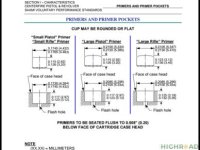IMHO it depends on what you're trying to do with your reloads and the expectations you have with them.
The 45acp brass is extremely forgiving, same for the 9mm brass. I do sort headstamps and only use cci/blazer/w-w/federal brass.
For blammo ammo with the 38spl/357/44spl/44mag I use any brass I can get my hands on. When I want to try to make a better/more accurate ammo I use the same lot/mfg brass.
The bullet you use and the type/amount of crimp you use will have more affect on accuracy then your mixed brass. It all comes down to the neck tension and how consistent you can get the short start pressure of your reload.
Several years ago I was working up loads for bowling pins. We use 12ga shells instead of bowling pins, same rules just smaller targets. Anyway was using w-w 38spl wc brass and cast bullets. These were the test loads. On the left is a mp 640 series 158hr hp and on the right is a h&g #50 wc.
The revolver I tested the loads in. Testing was done @ 50ft rested with the pistol scoped (7x dot reticle).
What those bullet/load/revolver combo's did.
A couple weeks later I was testing 357mag loads using the same revolver/scope/50ft bench & rest. Didn't matter what I did kept getting groups like these.
I was using the 110gr wc (far left) for those test loads.
Turned out the brass I was using was pretty much done. Tons of split ends on the case mouths. Ended up going thru all my 357 brass and scrapping most of it (1/2 a 5 gallon bucket). Bought 2000 new pieces of brass from starline and life is good again.
I leave all my revolvers/pistols stock so I don't have any issues with primers. I use federal primers for target loads in the 38spl's, 9mm's,44spl's,44mags, 45acp's. For blammo ammo in the 357's and 9mm's I use small rifle primers and any lp primer I can get my hands on for the 44mag & 45acp.






